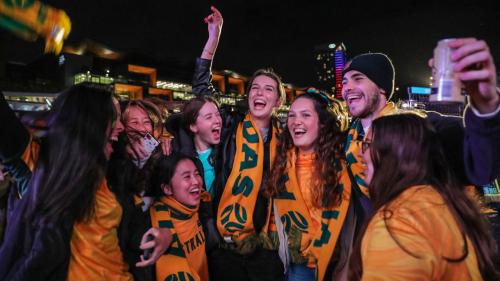 Fans at Sydney’s FIFA Fan Site celebrate after watching the Matildas win their round of 16 match against Denmark on August 7. Roni Bintang/Getty Images Brisbane, Australia CNN —
Fans at Sydney’s FIFA Fan Site celebrate after watching the Matildas win their round of 16 match against Denmark on August 7. Roni Bintang/Getty Images Brisbane, Australia CNN —
Less than a month ago, Australian cinemas were packed with Barbie fans wearing pink in honor of Margot Robbie, the local “Neighbours” actor turned Hollywood megastar.
Robbie’s girl power partnership with director Greta Gerwig proved a hit in global box office takings and somehow made wearing cutesy shades of pink a statement of feminist strength.
But now, seemingly in the blink of an eye, we’re all wearing green and gold for our newest heroes, Australia’s Women’s World Cup hopefuls, the Matildas.
Like Barbie, support for the Matildas was initially backed by a strategic marketing plan to introduce them to new audiences and tap into existing feelgood vibes and loyalties.
But in recent weeks, as they’ve fought to score goals against the best teams in the world, their grit, determination, and teamwork has elevated them into the stratosphere of Aussie culture. And unlike Barbie, these women are real.
The tremendous following for famous Chelsea forward Sam Kerr has broadened to the rest of the team, and now several players unknown to the general public just a few weeks ago are household names: Mary Fowler, Caitlin Foord, Hayley Raso.
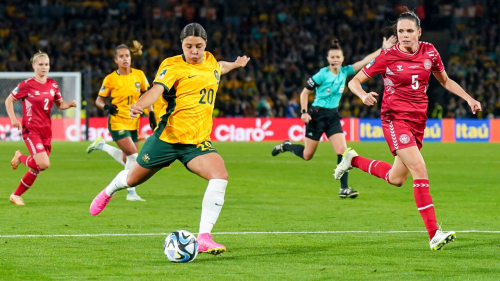 Sam Kerr takes the ball during a FIFA World Cup 2023 round of 16 match between Australia and Denmark at Stadium Australia on August 7. Daniela Porcelli/ISI Photos/Getty Images
Sam Kerr takes the ball during a FIFA World Cup 2023 round of 16 match between Australia and Denmark at Stadium Australia on August 7. Daniela Porcelli/ISI Photos/Getty Images
Tickets to the Matildas’ quarterfinals clash against France at Brisbane Stadium on Saturday have sold out and venues across the country are preparing for bumper crowds.
“We’re opening up the car park for the day,” said Jackie Schougaard, venue manager of The Alfred Hotel on Caxton Street, a few minutes’ walk from Brisbane Stadium.
“It’s like the Olympics, where everyone’s all of a sudden involved and experts in it,” said Schougaard. “Everyone’s got the odds on who’s going to win, and who’s the most likely first scorer, and everything like that. It’s just been unreal.”
Unprecedented audiences
The Matildas’ Monday night clash with Denmark broke viewing records, drawing an average 3.56 million viewers on free-to-air TV across the country, not including paid subscription packages.
In a post on X, formerly known as Twitter, Jason Lassey, blogger and editor of Footy Industry, said the match had outrated several major men’s games in two rival football codes – rugby league and AFL (Australian Football League) – then spent the best part of the day fending off attacks from incredulous sports fans.
“A lot of people just frankly don’t want to believe women’s sport is doing well,” Lassey told CNN.
If you are playing at home, Matildas last night outrated:
Every NRL Grand Final and every Origin since 2016
The 2022, 2019, 2018, 2017 AFL Grand FInal (but not 2021, 2020)— sportsindustry (@footyindustryAU) August 8, 2023
Among his critics were people who took issue with comparing an international event with a local competition, while others raised the point that there was no other sport on television that night.
“I’m not one who subscribes to the idea that every negative post in terms of women’s TV ratings or women’s sport is grounded in misogyny … but think a large part of it is people just don’t believe the game is worth it,” he said.
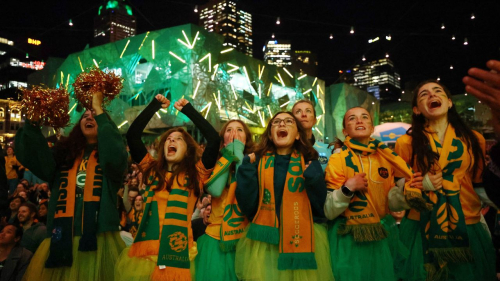 Australia fans watch their team’s game against Denmark at a fan zone in Melbourne on August 7. Hannah Mckay/Reuters
Australia fans watch their team’s game against Denmark at a fan zone in Melbourne on August 7. Hannah Mckay/Reuters
That attitude is refuted by huge numbers at the grounds – the same Denmark match drew a sell-out crowd of more than 75,000 people at Sydney Stadium – young families and grandparents wearing newly bought green and gold scarves and beanies.
Some of the appeal may have been the relatively cheap ticket price – for a family of five, it cost more to see Barbie during the film’s opening weekend than a 90-minute live World Cup game – and in the stands, making noise is actively encouraged.
Sitting on plastic seats, children munched on hot chips, held handmade signs and jumped to their feet to see the action over the heads of adults who themselves were yelling chants and frantically waving as their faces flashed up on the big screen.
In an interview with radio station 3AW, veteran Australian sports commentator Bruce McAvaney, who was at the game, somewhat cautiously noted the difference in the crowd from other major sporting codes.
“There’s something about being at these matches that is different to going to big matches where males are dominating,” he said. “It’s a friendlier feeling. Am I making that up? No, I’m not, because a lot of people have said that to me.”
“It feels a safer environment in some ways. There are so many young children there,” he added. “Maybe we can learn something from this.”
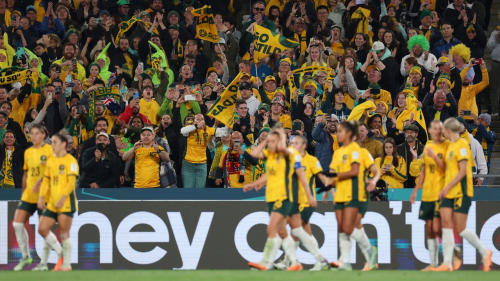 Fans react after Caitlin Foord of Australia scores against Denmark at Stadium Australia on August 7. Maddie Meyer/FIFA/Getty Images
Fans react after Caitlin Foord of Australia scores against Denmark at Stadium Australia on August 7. Maddie Meyer/FIFA/Getty Images
Demographic shift
Australia has a reputation as a sports-loving nation, but women are underrepresented in most aspects of organized sport – whether as participants, coaches, officials, administrators or board members.
Football Australia said part of the rationale for bringing the Women’s World Cup to Australia was to use it to grow the women’s game – backed by a 357 million Australian dollar ($232 million) FIFA legacy fund.
But even with the money, it’s a tough task in a market with traditionally poor backing for women’s sport.
Australia’s national netball team, the Diamonds, have long struggled for sponsorship, and this week, after winning the world championships, they went home with no prize money.
Kevin Argus, a senior lecturer in Design Thinking and Marketing at the Royal Melbourne Institute of Technology (RMIT), says the tide is turning for women’s sport as younger generations, who value social and environmental wellbeing, start to wield electoral influence.
“(There’s) this overwhelming sense that, if you are not deemed to be fair to women, you will be punished. We know politicians act in self interest, so there is this big shift now towards embracing women’s issues,” he said.
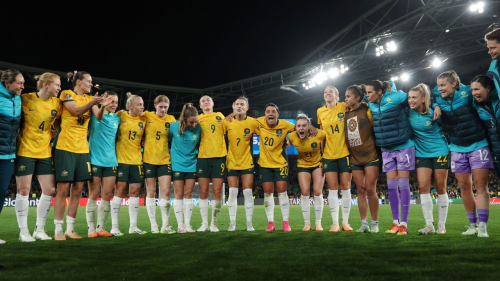 Captain Sam Kerr of Australia speaks to her teammates after her team’s 2-0 victory over Denmark at Stadium Australia on August 7. Maddie Meyer/FIFA/Getty Images
Captain Sam Kerr of Australia speaks to her teammates after her team’s 2-0 victory over Denmark at Stadium Australia on August 7. Maddie Meyer/FIFA/Getty Images
With investment and pay comes the expertise and training that makes young hopefuls winners on the field.
The Matildas only secured the same pay and privileges as Australia’s men’s team, the Socceroos, in 2019. And now some are earning much more than their teammates after signing with elite European clubs.
“Enough of these women are being well-funded enough to really perform to their optimum,” Argus said. “What we’re seeing is a quality of sport that has really exceeded many people’s expectations.”
You can see that in the stands, as crowds gasp and shriek, often cheering for both sides as teams battle it out on the field.
Argus says the World Cup is a turning point for women’s sport because the turnout and viewing numbers have proven that there’s an enthusiastic audience.
“Brands will jump on women’s sport and they’ll start to realize, ‘hang on, the voices of old and what we’ve heard – that it’s not as good, or people aren’t as interested – is really just a symptom of not giving people a go in the past’ … but moving forward, they have to,” he said.
Lassey fears those old voices, and a competitive schedule that pits soccer against cricket in Australia’s summer months, will prove insurmountable for women’s football.
“The challenge now is keeping the support going after the World Cup, particularly in Australia, where women’s soccer typically has an average crowd of about 1,500,” said Lassey.
“Some games are played on little more than park facilities with 300 or 400 people attending. We’re one step away from having cars parked around the oval, and people beeping their horns at players while they go try and score goals,” he said.
That’s why Lassey’s sharing and analyzing as many viewing figures as he can – to prove that women’s sport can pull spectators, because he says numbers are the only way to boost investment. But even then, he has doubts.
“The Matildas are right now very popular, but women’s soccer?” Lassey asked. “I would love to see it go somewhere after this, but whether it can, I don’t know.”
In their multi-country promotional tour, Robbie and Gerwig touted “Barbie” as a feminist film because it spreads the message that an almost exclusively “Barbieland” is no better than a patriarchal “Kendom.”
“It’s feminist in a way that includes everyone,” Gerwig recently told the Australian Broadcasting Corporation. “It’s a rising tide lifts all boats version of it.”
As Australians embrace the Matildas, and hopefully cheer them on to the final, it could be that they’re supporting something even more significant than the country’s first ever Women’s World Cup win.
